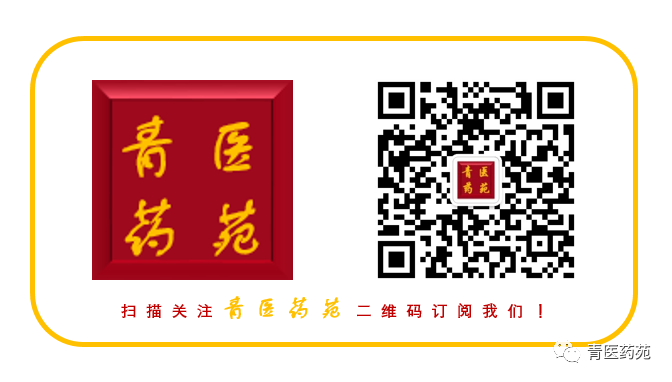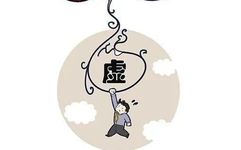 Kidney Yang Deficiency (Shen Yang Xu) is a term in Traditional Chinese Medicine (TCM). It refers to a type of deficiency-cold syndrome characterized by the decline of kidney yang, leading to a failure in warming and the loss of qi transformation. This condition is often caused by a constitution of yang deficiency, aging-related kidney depletion, prolonged illness harming the kidneys, or excessive sexual activity.
Kidney Yang Deficiency (Shen Yang Xu) is a term in Traditional Chinese Medicine (TCM). It refers to a type of deficiency-cold syndrome characterized by the decline of kidney yang, leading to a failure in warming and the loss of qi transformation. This condition is often caused by a constitution of yang deficiency, aging-related kidney depletion, prolonged illness harming the kidneys, or excessive sexual activity.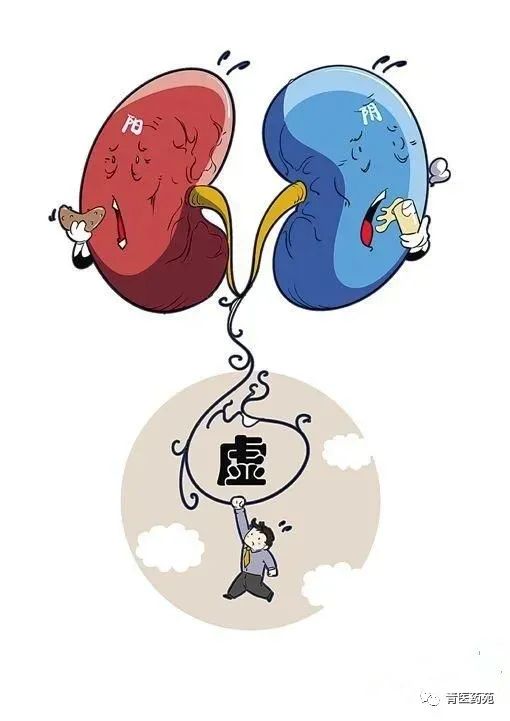 The kidneys govern water, and kidney yang plays a crucial role in the transformation and vaporization of fluids. When kidney yang is insufficient, the ability to vaporize and transform is weakened, leading to symptoms such as clear and prolonged urination, indicating pathological changes in the kidneys. Kidney deficiency often develops over a long period, and one should not hastily use potent tonics or unclear kidney-tonifying medications; instead, a gradual approach to regulation is recommended. Kidney yang is also referred to as Yuan Yang, Zhen Yang, or Zhen Huo, and is the root of the twelve meridians, with the essence of life originating from the kidneys. The kidneys and the Ming Men (Gate of Life) share the same qi, serving as the pivot for the balance of yin and yang in the body. Kidney yang governs the body’s yang qi, and when the fire is weak, symptoms of yang deficiency emerge.
The kidneys govern water, and kidney yang plays a crucial role in the transformation and vaporization of fluids. When kidney yang is insufficient, the ability to vaporize and transform is weakened, leading to symptoms such as clear and prolonged urination, indicating pathological changes in the kidneys. Kidney deficiency often develops over a long period, and one should not hastily use potent tonics or unclear kidney-tonifying medications; instead, a gradual approach to regulation is recommended. Kidney yang is also referred to as Yuan Yang, Zhen Yang, or Zhen Huo, and is the root of the twelve meridians, with the essence of life originating from the kidneys. The kidneys and the Ming Men (Gate of Life) share the same qi, serving as the pivot for the balance of yin and yang in the body. Kidney yang governs the body’s yang qi, and when the fire is weak, symptoms of yang deficiency emerge.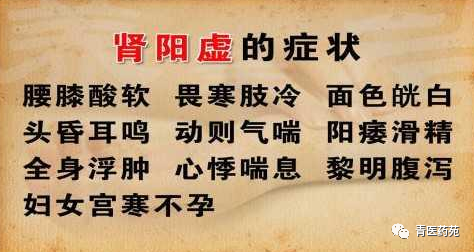 Common Symptoms: soreness and cold pain in the lower back and knees, cold limbs, fear of cold, mental fatigue, male impotence and premature ejaculation, female cold uterus and infertility.
Common Symptoms: soreness and cold pain in the lower back and knees, cold limbs, fear of cold, mental fatigue, male impotence and premature ejaculation, female cold uterus and infertility.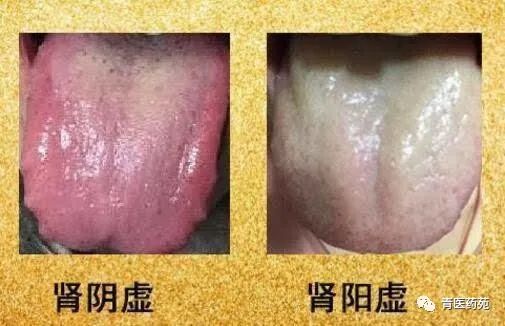 Main Causes: constitution of yang deficiency, aging, prolonged illness, excessive sexual activity! Treatment Principles The primary treatment for kidney yang deficiency is to warm and tonify kidney yang. However, it can appear in various diseases, and the clinical manifestations are distinct, leading to different treatment methods. In cases of deficiency-labor, the treatment should focus on warming and tonifying kidney yang while nourishing essence and blood.
Main Causes: constitution of yang deficiency, aging, prolonged illness, excessive sexual activity! Treatment Principles The primary treatment for kidney yang deficiency is to warm and tonify kidney yang. However, it can appear in various diseases, and the clinical manifestations are distinct, leading to different treatment methods. In cases of deficiency-labor, the treatment should focus on warming and tonifying kidney yang while nourishing essence and blood.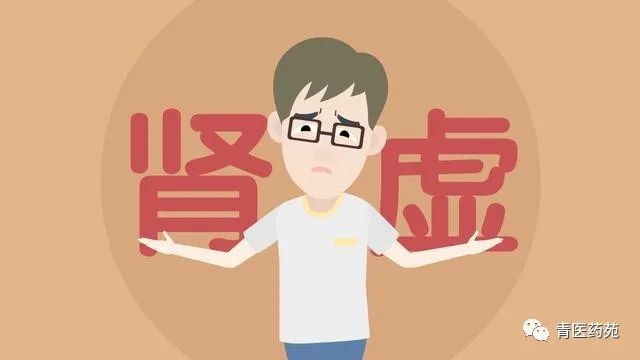 In cases of impotence, the treatment should tonify the kidneys and strengthen yang. In cases of diarrhea, the treatment should tonify the kidneys and strengthen the spleen. In cases of lower back pain, the treatment should tonify the kidneys and assist yang, strengthening the lower back and spine. In cases of edema, the treatment should warm and tonify kidney yang. Commonly Used Chinese Herbs TCM believes that the kidneys are the root of the body’s yang qi. For those with yang deficiency, the primary principles are to tonify the kidneys, warm yang, strengthen the foundation, and enhance physical health. Commonly used herbs with yang tonifying effects include: Lu Rong (Deer Antler Velvet), Hai Gou Shen (Sea Dog Kidney), Zi He Che (Placenta of the Purple River), Jiu Xiang Chong (Nine Fragrant Insect), Bu Gu Zhi (Psoralea Fruit), Du Zhong (Eucommia Bark), Xu Duan (Dipsacus), Rou Cong Rong (Cistanche), Ba Ji Tian (Morinda Root), Sha Yuan Zi (Astragalus Seed), Gu Sui Bu (Drynaria), Gou Ji (Cibotium), and Hu Lu Ba (Fenugreek). The best time for physical tonification is during winter, using methods such as gāo fāng (tonic pastes) and shí bǔ (dietary supplements). In particular, Hong Shen (Red Ginseng) is suitable for those with weak constitutions. This method has significant effects in preventing and treating diseases, nourishing and strengthening the body, and anti-aging, making it highly regarded by people. Basic Formulas
In cases of impotence, the treatment should tonify the kidneys and strengthen yang. In cases of diarrhea, the treatment should tonify the kidneys and strengthen the spleen. In cases of lower back pain, the treatment should tonify the kidneys and assist yang, strengthening the lower back and spine. In cases of edema, the treatment should warm and tonify kidney yang. Commonly Used Chinese Herbs TCM believes that the kidneys are the root of the body’s yang qi. For those with yang deficiency, the primary principles are to tonify the kidneys, warm yang, strengthen the foundation, and enhance physical health. Commonly used herbs with yang tonifying effects include: Lu Rong (Deer Antler Velvet), Hai Gou Shen (Sea Dog Kidney), Zi He Che (Placenta of the Purple River), Jiu Xiang Chong (Nine Fragrant Insect), Bu Gu Zhi (Psoralea Fruit), Du Zhong (Eucommia Bark), Xu Duan (Dipsacus), Rou Cong Rong (Cistanche), Ba Ji Tian (Morinda Root), Sha Yuan Zi (Astragalus Seed), Gu Sui Bu (Drynaria), Gou Ji (Cibotium), and Hu Lu Ba (Fenugreek). The best time for physical tonification is during winter, using methods such as gāo fāng (tonic pastes) and shí bǔ (dietary supplements). In particular, Hong Shen (Red Ginseng) is suitable for those with weak constitutions. This method has significant effects in preventing and treating diseases, nourishing and strengthening the body, and anti-aging, making it highly regarded by people. Basic Formulas
1. Jin Gui Shen Qi Wan
Jin Gui Shen Qi Wan originates from the Jin Gui Yao Lue compiled by Lin Yi and others during the Northern Song Dynasty. This book records 205 formulas, but only Jin Gui Shen Qi Wan is named with the term “Jin Gui,” indicating its high value.
Jin Gui Shen Qi Wan, also known as Ba Wei Shen Qi Wan (Eight Ingredients Kidney Qi Pill), consists of eight herbs: Gan Di Huang (Rehmannia Root), Shan Yao (Chinese Yam), Shan Zhu Yu (Cornus Fruit), Zei Ke (Alisma), Fu Ling (Poria), Mu Dan Pi (Moutan Cortex), Gui Zhi (Cinnamon Twig), and Fu Zi (Aconite, processed). Each herb has its role: Gan Di Huang nourishes essence and blood, fills the bone marrow; Shan Yao strengthens the spleen qi and consolidates kidney essence; Shan Zhu Yu tonifies liver and kidneys, astringes essence and qi, forming the “Three Tonics”;
Fu Ling promotes dampness and eliminates turbidity; Zei Ke regulates water pathways; Mu Dan Pi clears excess heat, forming the “Three Drains.” The combination of “Three Tonics and Three Drains,” along with warming kidney and consolidating yang herbs like Gui Zhi and Fu Zi, achieves the effect of nourishing yin while benefiting yang, and nourishing yang while supporting yin.
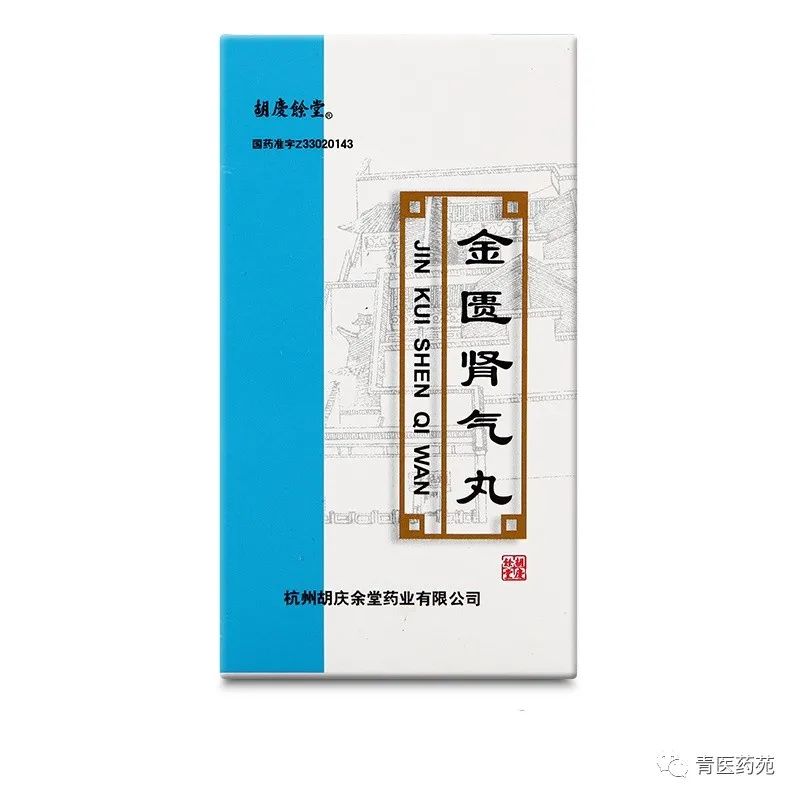
It warms and tonifies kidney yang, transforms qi, and promotes water metabolism. It is suitable for patients with symptoms of kidney yang deficiency such as lower back pain, weakness in the legs, abdominal tightness, fear of cold, cold limbs, difficulty urinating, frequent urination, and edema.
2. Gui Fu Di Huang Wan
Gui Fu Di Huang Wan is derived from Zhang Zhongjing’s Jin Gui Yao Lue and is the ancestor of kidney qi pills, including Jin Gui Shen Qi Wan, Ji Sheng Shen Qi Wan, and the Di Huang Wan series, originally using Sheng Di Huang (Raw Rehmannia) and Gui Zhi (Cinnamon Twig).
Sheng Di Huang cools heat and nourishes blood, while Shu Di Huang (Cooked Rehmannia) is sweet and slightly warm, specializing in nourishing blood, enriching yin, and filling essence. Modern derivatives use Shu Di Huang.
Gui Zhi and Rou Gui (Cinnamon) both have the effects of warming the meridians and dispelling cold to relieve pain.
However, Gui Zhi is spicy and warm, tending to ascend and disperse cold, warming the meridians in the limbs.
Rou Gui is spicy and hot, tending to warm the lower jiao, making it a key herb for treating the decline of Ming Men fire.
Thus, compared to the ancestral formula of kidney qi pills, Gui Fu Di Huang Wan enhances the effect of warming and tonifying kidney yang.
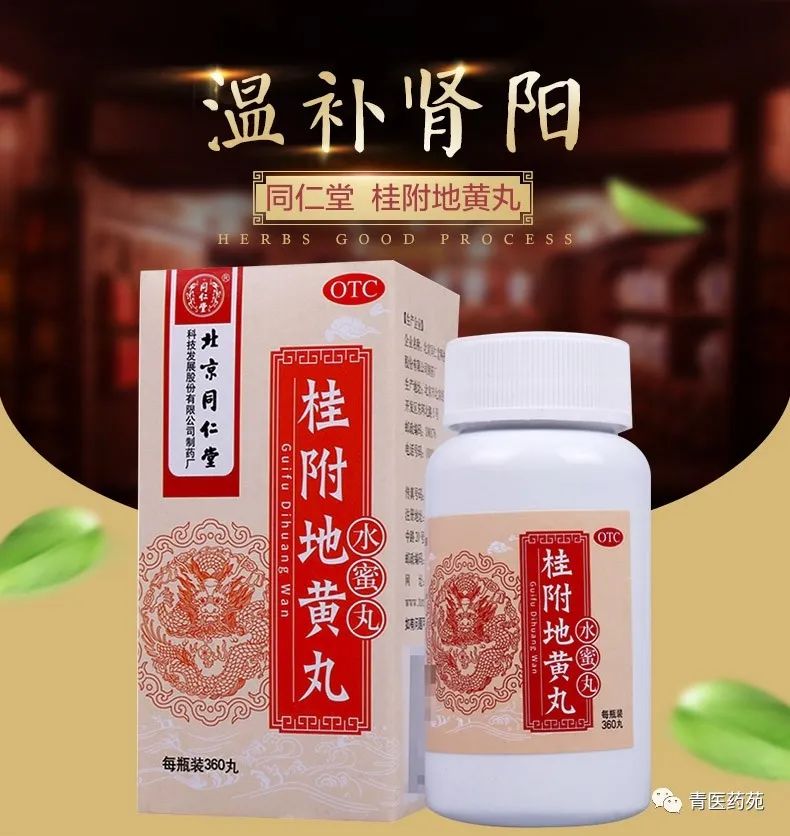
It is a tonic that, based on the nourishing liver and kidney yin of the Liu Wei Di Huang Wan, adds Rou Gui and Fu Zi to warm and tonify kidney yang, achieving the goal of “nourishing the source of fire to dispel yin shadows.”
It warms and tonifies kidney yang, suitable for conditions caused by kidney yang deficiency such as cold limbs, abdominal pain, clear and prolonged urination, loose stools, impotence, nocturnal emissions, diabetes, or female infertility due to cold uterus.
Note: Medications should be used under the guidance of a physician or pharmacist; do not self-medicate!
